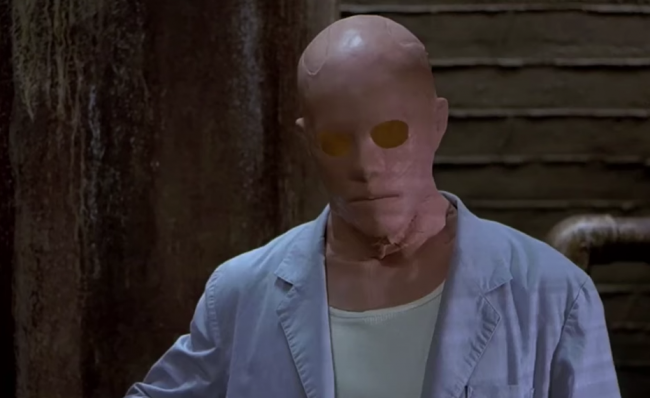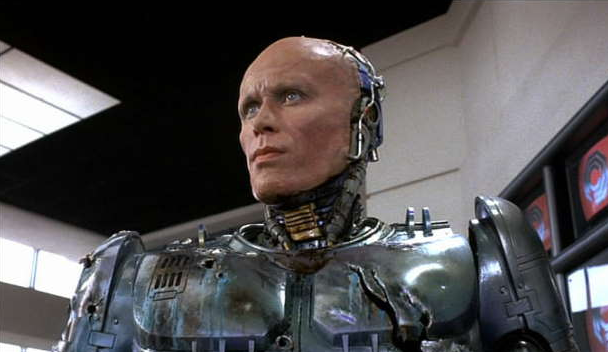What To Watch: Flipping ‘RoboCop’ Heroism in Paul Verhoeven’s ‘Hollow Man’ (2000)
This flawed thriller is an interesting comparison with the director's first American film.
Hollow Man is a 2000 action/horror film about a team of scientists who unlock the power to turn a person invisible, only to have that power turned against them.
There’s probably not a one of us who hasn’t at least once in our lives imagined what it would be like to be totally unseen, to move about the world free of notice by anyone, completely invisible. Think of the possibilities. Seriously. What would you do? How long you think before those possibilities turned dark? Probably not long. Right? You went from strolling about museums and attending any college class you want to sneaking into movie theaters, peeking on that good looking neighbor in the shower, robbing banks and who knows what else ‘cuz we all want to be bad and get away with it. We just don’t admit it.

That’s exactly the thinking behind Hollow Man, a disturbing psychological horror that follows the breakdown of one such man who, earning that power, goes mad with it, the voyeur within overpowering him until he runs wholly out of control. It’s a scary thought, one that has fascinated Hollywood for decades, having produced many films and television programs around it. While Hollow Man is easily the most visually spectacular of the lot, it fell under criticism for its untapped potential and dark themes, of which much is earned, however the film deserves a closer look for some of the more subtle underpinnings and symbolism and for the director, a kind of inverse of his own work. Let’s take a look.
THE STORY: The film stars Kevin Bacon as Sebastian Caine, a name that hints already of the fate of the character, the Biblical Cain having betrayal and violence within him. Caine is the leader of a group of scientists that have developed a special serum that turns subjects invisible, including the largest of the set, a female gorilla. Motivated by the results, Caine pushes for human testing, and not being entirely honest with his military backers, assigns himself the first test subject. This is guy who wants to be in the history books.

The procedure is devastatingly painful but ultimately successful and sure enough, the man disappears in one of many startling visual effects shots that sees the character step-by-step, layer-by-layer, from skin to muscle to organs to bone go to nothing. At least what we see. It’s a monumental scientific breakthrough that would seem to be the start of something enlightening for the team and mankind as a whole, though that’s not all what happens as Sebastian soon discovers the effects are not reversible as performed on the gorilla. He’s stuck this way, and it’s not a good thing. Quarantined and studied, he quickly grows weary of the isolation and delusional, becoming slowly unstable until he eventually frees himself of the laboratory and goes on a rampage, first on a beautiful girl in his apartment building, then on his fellow scientists.
WHAT TO LOOK FOR: The film is directed by Paul Verhoeven, whom I chose to write about again after discussing RoboCop earlier, his first American release, seeing a link between that film and this one. The Dutch director gained notoriety with his future cop story and also other graphically sexual and violent films such as Basic Instinct and Starship Troopers, but with Hollow Man, he wanted to make a more traditional Hollywood blockbuster, one less focused on gratuitous sex and gore, which immediately sounds odd when looking at a film that features graphic visuals of internal anatomy and a scene of rape.
That’s right, rape, which will get more detail in a moment, but before that, what’s really interesting about Hollow Man is how it can be viewed in reflection of RoboCop, two stories about men transformed by something that that gives them great power who do opposite with it, leaving them both broken by the procedure but pursuing vastly different outcomes because of it. Officer Murphy (Peter Weller) in RoboCop uses the the loss of his body as a cause for redemption, using his cyberborg replacements as a weapon to fight the injustice.

Caine, on the other hand, takes the loss of his body as motivation for experimenting with immorality and unethical behavior, finding that his powers offer him what he feels is a sort of obligation to be, well, very bad. A ‘gift’ he calls it. In contrast to Murphy, Verhoeven creates a character designed to gain to our loyalty that then wholly betrays it in stages, testing our resolve in sticking with Caine. We are taken in by the formula of movie plots to cling to the star, that no matter his disgraces, he will find redemption.

How long will we side with him though? How bad does he need to be? When will our blind trust finally break and realize we must abandon who is supposed to be the hero? With Caine, we get hints he is traveling along a troubling path with some cruel (and sexually-deviant) pranks on his fellow scientist, but we still have hope though that all of it will change, yet when he heads to his apartment and looks in on his neighbor, if we haven’t already shed our loyalty to him as the hero, we do now.
A GREAT MOMENT: Typically in this series of What To Watch, this section is dedicated to highlighting a moment that deserves attention for its powerful impact on the selected movie, almost always in a positive way, however, it’s a little disconcerting to call the sexual attack of an innocent woman a ‘great moment.’ However, the rape of Sebastian’s neighbor (Rhona Mitra) is a particularly jarring moment that shifts everything about what we expect from both the Caine character and the film itself, clearly separating–for most–our belief in recovery for Sebastian. He’s gone for good.

Up to this moment, Caine, now invisible, has been playfully mischievous with his condition, toying with his colleagues, though hints of what is coming are beginning to show. While one of the women (Kim Dickens) on his team fell to napping in a chair, he took advantage of her, undoing her top and fondling her, an already squirm-inducing moment that escalates when another of the scientists, Linda (Elisabeth Shue), his ex-girlfriend, stays late one evening, and when she and Caine are alone, he attempts to seduce her, though it doesn’t work.

Frustrated by his situation yet feeling more empowered, he ignores directions to stay in the lab and heads to his apartment to gather some things, but once there, catches a glimpse of the girl next door and, lured by his desire for her, tests his courage further, ringing her doorbell and slipping inside. Once there, the young woman, in only a flimsy robe that exposes her body, is too much for Caine and in a move that leaps well over the line, attack and pins her to the bed, violating her in the worst way. It’s a terrifying and traumatic moment that shakes the horrified and confused woman but also pushes the audience well to one side, forever keeping Caine in darkness, just as Verhoeven intended.

This moment is a controversial one and while the film itself deals in misogyny and violence towards women perhaps a little too exploitatively, this specific moment is what the movie needs in capitalizing on the premise it sets up, forcing Caine to be the worst kind of villain so that the retribution he gets in the end is earned. Like Murphy in RoboCop, this is a journey of violence but unlike the good cop turned cybernetic protector of the people, Caine allows his power to corrupt. Murphy’s visit home, as discussed (again, here) is about finding identity while Caine’s return home is a springboard for sickening menace. These are men with tremendous who split with reality but take opposing paths. Verhoeven dabbles with the psychology of power and loss with both characters, taking them entirely in different directions even as parallels exist.
THE TALLY: Hollow Man is a title with a double meaning, one that accurately describes an invisible man but more so, the man in the movie made invisible. Caine is a callous, self-centered egomaniac looking for notoriety before he is transformed but afterward, a creature with no morals who is empty of the very markers that would identify him as being a person worthy of humanity.

While the movie ultimately wastes a number of opportunities to explore what that means, devolving into a standard slasher horror film with wicked cool visual effects, the underlying theme of what potential lies just beneath our skin is frightful, that we are, as a species, for the most part, ethically bound by the very existence of our visible selves. With the consequences of that stripped away, the movies suggests we are at the will of a much darker inner force that seems lying in wait, checked by the flesh that binds us. Contrast that with Verhoeven’s RoboCop and it’s a different message, that hollow or not, we are capable of good conscience, even greatness. Either way, the two raise some interesting questions. Hollow Man is not as good as RoboCop, but looking past the story’s direction, it’s nonetheless a challenging film. It’s what to watch.
